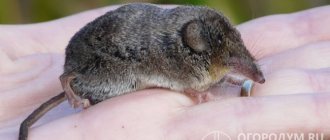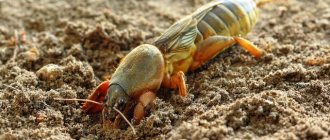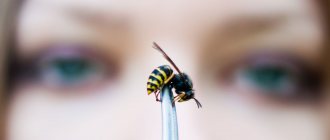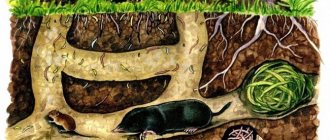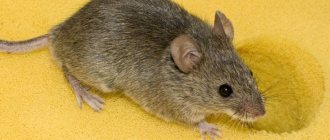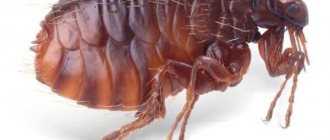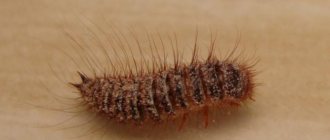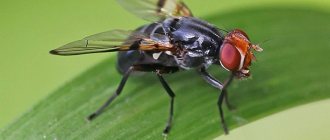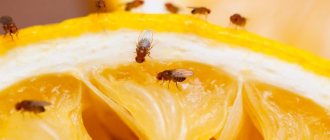Another pest that plagues gardeners is the shrew. Once there is an animal on the property, it can be quite difficult to get rid of it. Its presence can be seen by small mounds rising above the surface of the earth. It is believed that it is even useful. But gardeners have a completely different opinion. Why? This question and how to get rid of it on the site will be answered in the article.
What does a shrew eat?
Animals are omnivores; the main food is insects, their larvae, and earthworms. They do not disdain small frogs, lizards, and young small rodents. Food is found using smell and touch. Shrews are constantly looking for food. During the day they eat an amount of food that exceeds 2 or more times their own weight. They take short naps between meals. There are about 80 such cycles per day. Without food, shrews die within 7-9 hours, or fall into short-term torpor with a decrease in body temperature. They do not hibernate.
Prevention of occurrence
No one has yet managed to protect their site 100% from the appearance of various pests, including shrews. If there are few shrews, then they are only useful, but over time their population increases, and their benefit turns into harm. Unfortunately, this happens late and you have to think about how to get rid of them, otherwise serious crop losses are possible.
There are a number of options for using various homemade devices or planting plants that help a person fight the invasion of animals. For example:
- Repellers based on a wooden stick with plastic or cans on it work well. The noise generated by the wind scares away underground burrowing animals.
- Planting plants such as beans and other legumes, as well as mint, wormwood and other plants that have a persistent aroma, also helps regulate the number of these animals on the site.
Although traditional methods have their advantages, they do not provide the same effectiveness as chemicals or modern electronic devices.
When choosing one or another method of control, you should remember that these are mainly useful animals, unlike rats and mice.
Benefits and harms
Due to their omnivorous nature, it is believed that shrews bring benefits by destroying soil insects and their larvae. Moreover, the process occurs all year round and in places that are difficult to reach for other insectivorous mammals: under snow, stones, trees, and in the depths of burrows.
Shrews emit a strong unpleasant odor, which causes some animals to leave them uneaten (foxes, domestic cats). However, this smell does not frighten owls, weasels and ferrets, who eat them without any disgust.
Despite the fact that the soil where the animals live becomes loose and enriched with oxygen, it is not suitable for growing any plants.
The nimble animals are constantly in search of food, so they have to constantly dig through the surface layer, breaking through peculiar tunnels. At the same time, shrews damage the root system of plants encountered along their path. The soil thrown to the surface becomes an obstacle for the fishing line on the trimmers. Having encountered such mounds of earth, it instantly breaks.
Reasons for appearance
Shrews, like other similar creatures, constantly carry out natural migrations in search of suitable places for their livelihoods. But this does not mean at all that it can appear in any area, since this requires certain conditions. Even if there is a lot of food in the area, but there is little moisture, the shrew is unlikely to appear. Hard soil that is not watered or does not have natural moisture does not allow the animal to dig long passages. Therefore, this animal is most often found near water bodies or in areas that are watered on a regular basis.
Shrew
How to distinguish a shrew from a mole
Externally, shrews are similar to moles. What is their difference?
The mole is usually larger than the shrew, its length is up to 15 cm, and it weighs more - up to 100-140 g. The tail is approximately 4 cm long. Its head is elongated, elongated with a proboscis, making it similar to a shrew. The body is covered with dark velvety fur. Moreover, the hairs of the fur grow straight, allowing the animal to move underground in any direction; the pile lies easily in different directions.
The mole's paws are flipper-shaped, turned outward, with long claws. This allows the mole to easily break through tunnels in the ground. With its hind paws it throws the earth out of the hole. The eyes and ears are small and covered with hair.
Shrew , unlike the mole, is a small animal, up to 5 cm. The tail can be much longer than the length of its body. The fur is soft, velvety gray, like that of house mice. Unlike a mole, its paws are small, with small claws, and covered with light hair. The eyes are small, barely noticeable.
They can be distinguished by the appearance of their minks. If moles have mounds rising above the surface - molehills. Shrews only have holes in the ground; more often they occupy previously dug passages in moles, mice, rats, and hamsters.
general characteristics
The shrew family (Soricidae) belongs to the order of insectivores of the mammalian class. Externally, the shrew is similar to an ordinary mouse , but has a smaller body (from 3.5 to 18 cm long, weighing from 1.2-1.5 to 100-150 grams), with soft fluffy fur of a predominantly gray color and a very long tail. She has small, blind eyes above an elongated muzzle with an elongated proboscis nose and almost invisible ears on her head.
More than 20 species live in Russia, including the ubiquitous common shrew , whose sharp teeth are colored brown due to the presence of iron in the enamel (which explains its name). The body is covered with light brown hair and reaches no more than 8 cm in length and weighs 4-16 grams.
Common shrew (pictured)
From April to September, the female breeds 2-3 offspring, numbering from 4 to 14 cubs, bearing them for 13-28 days. 4 weeks after birth, the animals are ready for independent life, the duration of which is about 18 months.
When a mother shrew moves with her offspring, you can see them holding onto each other's tails with their teeth, as if they were playing "train"
How to get rid of shrews in your country house (garden)
How to get rid of shrews on the site is a question that worries many gardeners. After all, when animals appear in a summer cottage or garden, they create many problems. Moreover, the animal is nimble, rarely appears on the surface, and it is quite difficult to fight it. Methods for getting rid of shrews are similar to fighting moles. Use
- chemical,
- physical,
- mechanical,
- folk methods.
Chemicals
Find shrew burrows. Pour odorous substances into it, such as mothballs, tobacco, or fill the minks with diesel fuel.
Other effective remedies are “Hunter Anti-Rodent”, “Nutcracker”, “Ekar”, “Rat Death”, which cause suffocation and death in the animal. Products are purchased in specialized stores. Before use, you must read the instructions; do not use them near trees and bushes.
Since chemicals are potent, when working with them, wear protective clothing, a respirator or a cotton-gauze mask, and gloves.
Ordinary baits for mice or rats are also used, which are placed near the burrows.
Physical methods
Deterrents are used, such as pinwheels with tin cans and beer cans. Dangling on a stick stuck in the ground, they create a vibration that causes discomfort in the ground for the animals, forcing them to leave.
Some gardeners use firecrackers, which they throw into a hole and immediately cover it with earth. The use of ultrasonic repellers has a certain effect.
Mechanical methods
By flooding the burrows with water from a hose, the animals can be driven out of their burrows. Of course, they will have to be guarded when they escape from there, and somehow destroyed. Or use mole traps and traps, placing them in holes.
Traditional methods
Domestic cats can help fight shrews. Some hunting cats can catch them in the heat of the hunt. But they won’t eat them - the animals have special glands that secrete a pungent and unpleasant odor. This is their only defense against other small predators.
Try planting marigolds in your area; shrews don’t like their smell. Also, the animals do not like beans, beans, peas, or spurge. Perhaps the plants will scare away the shrews.
Reviews from gardeners
Konstantin, 64 years old, Rostov
The simplest methods helped to scare away shrews from a summer cottage: acoustic and “aromatic”. Before the autumn digging of the garden, dried marigolds crushed into dust were scattered, and rags soaked in turpentine were buried along the entire border of the plot. Pieces of rotten fish were placed in the holes. In case the shrews bypassed the bait, additional metal reinforcement was dug into the garden bed at a slight angle to the ground, to a depth of 40-50 cm. A plastic bottle was placed on it, which moved with a light blow of wind, and the noise from the vibration of the steel rod scared away the animals. Champagne bottles, also at an angle, were buried in the ground - the effect was the same - an unbearable roar was heard.
Veronica, 56 years old, Ryazan region
In the garden plot we did not decide to use poison or traps for humane reasons, so we save ourselves from shrews using the Grad ultrasonic device. I insert batteries into the device, seal it in a plastic bag and dig it near the holes to a depth of 10 cm. After 2-3 weeks I observe the complete disappearance of the pest. At the same time, ultrasonic waves do not have a harmful effect on animals and people.
Semyon, 48 years old, Krasnodar region
In my apiary in mid-November, a shrew got into the habit of emptying the hives. It is more dangerous than ordinary mice because it is small and very voracious. To drive it away, I placed a fine-mesh (size 6 mm) grate between the bottom and the lower body, but the tight holes prevented the bees from exiting. In March I replaced it with a mesh with 8-10 mm cells. In addition, I cleaned the hives of dirt and placed a pollen collector on the entrance. After that, all the problems with pests disappeared.
Animal diet
Now that you've learned that the type of mouse that digs the ground is called a shrew, it's worth becoming familiar with what they like to eat. The diet is quite varied, it includes:
- Caterpillars.
- May beetle larvae.
- Spiders.
- Worms.
- Woodlice.
- Weevils and others.
If an animal lacks food, it is able to switch to other food sources. In particular, seeds of coniferous and fruit-bearing trees can be consumed.
Metabolic processes in the animal's body occur very quickly, so fat reserves do not accumulate. This is due to the fact that the animal does not hibernate.
What kind of pest is this?
There is an opinion that the shrew can be confused with a field mouse. However, in practice this is quite difficult to do. Once you carefully examine the animal at least once, the analogy with voles will disappear forever.
The small body is covered with gray or gray-brown hair. Short legs. A long tail. These are all possible characteristics of similarity. There are much more differences. The shrew's skull is elongated and has a fairly large size in relation to the body. On the muzzle there is a characteristic “proboscis” - an elongated, slightly bent nose.
The size of the shrew depends on its age. A young individual can weigh literally a couple of grams and be no more than 3.5 cm long. Adults reach up to 150 g and 18 cm. The eyes are weak-sighted. The ears are small. In winter, body size decreases. The magical effect is caused by a high ability to adapt to circumstances - hibernation is excluded, and the amount of food is reduced.
Most often in the middle zone there are 2 types:
Dwarf shrew)
Gray-brown fur, sharp teeth, size about 7 cm. A distinctive feature is the drooping tail with pronounced villi.
Common shrew (forest)
Body length is about 5 cm, dark brown in color with light spots on the belly. Most common in dachas near forested areas.
The species also distinguishes the shrew from the mouse. The owner of the proboscis is not a rodent at all, but a mammal that eats insects.
Features of behavior
Shrews have little predictable behavior.
They suddenly appear on the site and can leave it forever for no apparent reason. It’s impossible to guess what exactly you liked or didn’t like about a particular area. Nevertheless, it was possible to notice the most common preferences.
Insectivorous animals like moist soil. It is easier to dig holes, build passages and make supplies in it. It is very difficult to create a deep labyrinth in hard ground.
Burrows are often found in regularly watered beds with dense vegetation, in grass near water bodies and in overgrown bushes.
Shrews are partial to greenhouses. If there is one or more on the site, the gardener should be prepared for raids - a couple of labyrinth passages will definitely be laid inside.
You can find a hole by deposits of branches, leaves, and locations of old settlements of moles, mice, mole rats, and rats. The animals do not hesitate to occupy empty “houses”, bravely defend their possessions and keep themselves apart from other animals. Usually it is the males who do the repelling. They use their musky scent to warn enemies. Only ferrets, owls and weasels do not respond to threats.
Shrews eat extremely quickly and a lot. They die from hunger for more than 7 hours, so every three hours they eat food according to their own body weight. This is the only way they can keep warm and maintain their metabolism during short sleep. The day is not divided into night and day time. The regime is designed to alternate between rest and hunting for beetles, larvae, worms, small frogs, and lizards.
Each summer period is accompanied by the appearance of at least 14 cubs from one female. Babies become independent at 4 weeks. Life expectancy is no more than one and a half years.
Expert opinion
Mityuk Stefania Bogdanovna
Sometimes shrews manifest themselves precisely during the period of breeding. On the site you can see trains of animals. This is how children follow their mother, holding each other’s tails.
It is easy to distinguish from rodents. The eaten crop is definitely not the work of shrews' teeth. They do not feed on root vegetables.
Chemical control agents
Toxic substances are used to kill shrews only when other methods do not help, and there are a lot of rodents. Stores sell various formulations that will help get rid of pests in a short time.
Effective chemicals:
- " The Nutcracker". Thick dough-like mass of green color. Place the product near the shrew's burrows and wait until the rodent eats the bait. After 3-4 days, the pests will begin to die.
- "Hunter Antirodent". Food bait (rounded, hard, red granules). Consumption of the drug per 1 ha is 1–3 kg. The bait is laid out on the area where the shrew has settled. The product attracts rodents, which die from suffocation after consuming poisonous granules.
- " Rat Death" The bait has a doughy consistency. The drug is placed near the burrows of rodents, which, after eating the bait, die from internal bleeding and suffocation.
Some summer residents use poisonous gas bombs to drive shrews away from their property. The device is lowered into the hole: the destructive gas spreads through the tunnels, poisoning the rodents.
Where does the shrew live?
Photo: Animal shrew
Various species of shrews have settled throughout our planet. They live almost everywhere, they can not be found only on the Australian continent, in the polar regions, New Zealand and New Guinea, as well as in parts of South America, which are south of countries such as Venezuela, Ecuador and Colombia.
These insectivorous creatures adapt to life in various territories:
- On flat areas;
- In mountain ranges (up to 4 km altitude);
- In deserts and semi-deserts;
- In tropical rainforests;
- In wetlands.
Each animal has its own domain, the territory of which it vigilantly guards to avoid encroachment by uninvited guests. If someone has invaded the shrew’s allotment, then a struggle for the hunting area begins, the outcome of which can be fatal for one of the rivals. Shrews enter into fights not only with their own kind, but also with mice and lizards.
Burrows serve as a refuge and home for shrews, but they themselves dig them infrequently, but try to occupy someone else’s hole left by someone else. If they have to dig their own shelter, they make it shallow.
Insectivorous creatures love the hollows of rotten trees, where they also set up their homes. In their dens, shrews make soft and comfortable bedding from last year's leaves. We can say with confidence that shrews are sedentary animals that adhere to a certain territory throughout their short lives.
Habitat
What attracts attention to this animal is its very small size. For this reason, they are usually considered to be the smallest predators on the planet . People who have frequently encountered shrews are aware of their aggressive nature, which explains their nickname “little devil.” In total, the shrew genus includes approximately 300 species, which can be represented in two families:
- shrews (with white teeth);
- shrews (with dark-colored teeth).
Among the most common representatives of the family, the following species are worth highlighting:
- tiny shrew;
- dwarf shrew;
- water cutter, etc.
You can meet these miniature animals in almost any part of the globe , since they thrive in areas with different climates.
Their habitat is very diverse: shrews live in South America, Colombia, the USA, and Russia. You won't find them except in the polar regions and Australia.
In our country, this family is represented by 20 species. The most common of them is the shrew. The animal has a very small body, which can reach 3-18 cm in length.
Population and species status
Photo: Shrew animal
As was said, shrews are widespread almost throughout the globe, with the exception of some areas, but the state of their population is quite ambiguous, it all depends on one or another variety of this animal. The population size of many shrews is stable and not subject to any threats, and some species are considered endangered and are listed in the Red Book.
If we talk about the shrew family as a whole, then only some species are considered endangered, and the numbers of other species do not cause any concern. We should not forget that these interesting insectivores have about three hundred varieties, so they are quite numerous and widely distributed across various continents, countries, regions and regions.
DIY shrew traps
A reliable, but labor-intensive and expensive way to combat rodents is to install a mechanical barrier. Conveniently performed at the fence installation stage. Dig a fine-mesh mesh around the perimeter of the site to a depth of 1.2 meters. Leave up to 20 cm of free edge on top. It is unlikely that a pest will dive under such a barrier.
A mousetrap with a pleasant-smelling bait is suitable as a trap for a shrew. It's easy to make a simple design with your own hands.
Options for homemade traps:
- Pipe trap. To make it, take a small diameter pipe and install shutters at both ends. They should close inward. Leave fragrant bait in the trap. As soon as the shrew presses its nose into one of the flaps, the flap will open slightly: the rodent will easily get inside, but will no longer be able to get out.
- Wire trap. Make a spacer, which you then install near the entrance to the hole. As soon as the mouse touches it, the locking mechanism will work. Throw away the caught rodent and install the spacer again. Load the trap until the shrews leave the area.
Some gardeners resort to more radical methods - they install traps near the minks that kill the pest. The device is equipped with sharp rods or knitting needles. When triggered, the trap pierces the rodent's body right through.
Cats will gladly take part in catching a rodent, although they do not eat them because of their specific smell. The best time for hunting is at night, when shrews are busy searching for food.
Nutrition
Shrews are designed in such a way that their digestive system must constantly work.
Therefore, they almost constantly have to hunt for food, taking only short rest breaks. Therefore, they live differently from all other animals. For them, the day is divided into two parts - hunting and sleep. Each animal lives its own day. For some they are divided into 10 intervals, for others it includes 78. In other words, the animal will have to go to bed and get up 78 times a day to get food. Shrews require a very large amount of food . They must constantly maintain a certain body temperature and always have a supply of energy. And this is only possible with the continuous process of digestion, which is inevitably accompanied by the release of heat. Therefore, they have to consume large amounts of food. Sometimes shrews eat an amount of food in a day that can be more than their own weight.
Lack of food is very dangerous for the life of a shrew: if in summer they can survive without food for no more than 8-10 hours, then in winter it is enough to remain without food for more than 3 hours for the death of the shrew to occur.
Food at different times of the year
The food of shrews is quite varied . It all depends on what time of year she gets food for herself.
- In spring and summer, it eats mainly insects: mole crickets, worms, slugs, caterpillars and woodlice. If an animal has not eaten for a long time, then it can behave like a predator and try to catch small rodents - mice. Water shrews feed on small fish and frogs;
- In winter, it is not so easy to get food for shrews. Bare soil no longer contains as much food as in summer. They have to break the snow cover to get to the soil, looking for insects in it. Shrews can also eat plant seeds. Considering that in winter there is very little food left, only the most persistent and active ones survive until spring.
Features of character and lifestyle
Photo: Garden shrew
Even today, little is known about the habits and behavior of shrews, because they have not been sufficiently studied, because they lead a mainly twilight lifestyle and are almost all the time in the bowels of the earth. Males and females are practically indistinguishable in appearance.
By nature, these animals are loners, each of them has their own land, which they carefully protect from strangers. A shrew can fiercely fight for its allotment of land against uninvited guests; it is not afraid to attack larger mice and lizards. Her temperament is very aggressive and hot-tempered.
On the other hand, this animal is very unbalanced and timid, the shrew’s nerves are not right; it can literally be scared to death even by a thunderstorm. Hibernation is unusual for these animals, but when there is little food, the shrew falls into a kind of short-term torpor, and its body temperature drops sharply at this moment.
Short-tailed shrews, which are registered in Canada and the USA, and water shrews, which live in our country along the banks of reservoirs, are poisonous animals, the bite of which is very painful even for humans and causes swelling of the bitten area, and for many small animals such a bite is simply fatal.
As for the life expectancy of a shrew, it is very short-lived and is only about one and a half years. It has been observed that females live a month longer than males. This is the interesting and dual nature of shrews: on the one hand, they are very nervous and timid, and on the other, they are aggressive and unpredictable.
